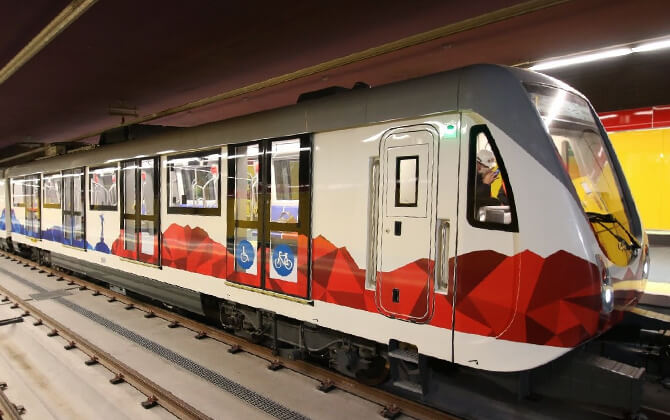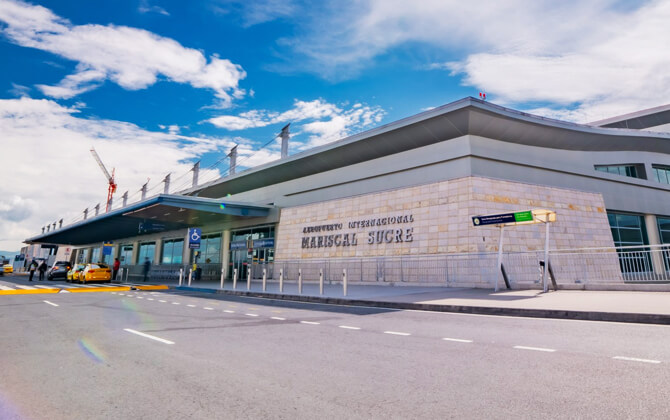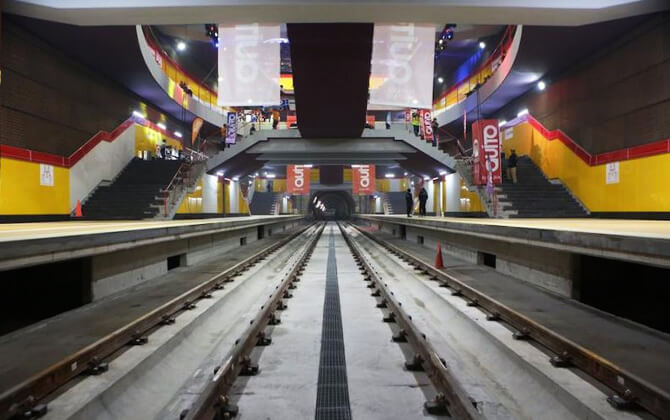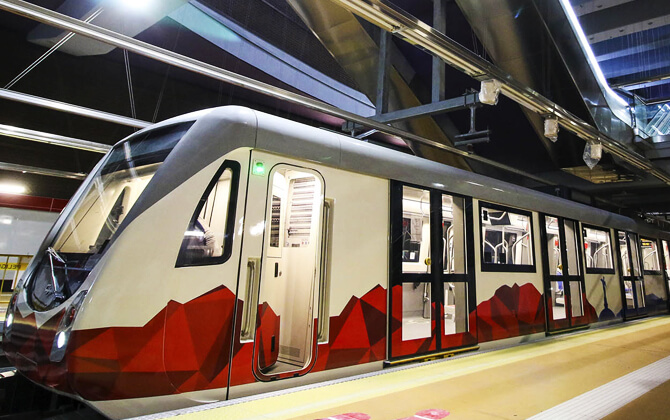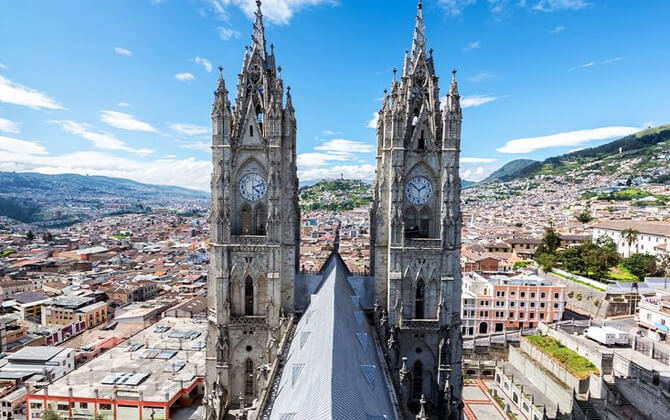The Quito Metro is Ecuador’s first rapid transit system, offering a modern and efficient way to move across the capital city. Line 1 runs fully underground for about 22.5 km (14 miles), linking the southern terminal at Quitumbe with the northern terminal at El Labrador.
This north–south line includes 15 stations that serve key districts and major landmarks of Quito. A full ride takes about 34 minutes, which is significantly faster than traveling by bus in traffic.
Located at an altitude of roughly 2,850 meters (9,350 feet) above sea level, the Quito Metro is the highest full metro system in the world. It marks an important step in improving urban transport, easing road congestion, and enhancing mobility for both residents and visitors.
Quito Metro Official Map 2025
The official Quito Metro map displays the single operational line — Line 1 — running north–south across the city. All 15 stations appear on the map, from Quitumbe in the far south to El Labrador in the north. With only one line in service, the map is simple and easy to read.
Quito Metro map showing 1 lines and all stations. Click on the map to enlarge it or download the Quito Metro map in PDF format.
Quito Metro Lines and Stations
The entire line is underground and built with modern technology, including electric trains and advanced safety systems. It covers about 22 km (14 miles) and includes 15 stations.
Trains consist of six cars, measuring 109 m in total, and can carry around 1,100 passengers. When fully utilized, the system can handle up to 400,000 riders per day. The metro uses a 1,500 V DC overhead catenary system and offers amenities such as air conditioning, LED information screens, and full accessibility for passengers with disabilities.
Line 1 connects a wide range of areas: it starts in the southern suburbs at Quitumbe, passes through residential districts, continues into the Historic Center, and reaches modern commercial zones before ending at El Labrador in the north. The line also links with Quito’s Metrobus-Q BRT corridors and several bus routes, making transfers straightforward. Each station features a distinct color scheme and clear signage for easy navigation.
Security is a key part of the system. Stations and trains are monitored by hundreds of CCTV cameras and staffed by security personnel working with national police.
List of All Quito Metro Stations
Line 1 has 15 stations, listed from south to north:
- Quitumbe – Southern terminus (connected to the Quitumbe bus terminal)
- Morán Valverde
- Solanda
- Cardenal de la Torre
- El Recreo
- La Magdalena
- San Francisco
- La Alameda
- El Ejido
- Universidad Central
- Pradera
- La Carolina
- Iñaquito
- Jipijapa
- El Labrador
Stations are named after their surrounding neighborhoods or nearby landmarks. For instance, San Francisco station sits close to Plaza San Francisco in the Historic Center, Universidad Central serves the main university campus, and El Recreo is next to a major bus hub and shopping center. Quitumbe and El Labrador, the two terminal stations, act as multimodal transport centers with connections to buses and shuttle services.
All stations are equipped with elevators or ramps, tactile flooring, and automated announcements to support safe and accessible travel.
Timetable & Operating Hours
The Quito Metro runs seven days a week with a wide daily service window. Hours are designed to suit commuters, students, and leisure travelers. Trains operate frequently, with shorter waits during rush hours and slightly longer intervals during quieter periods.
The First and Last Train
Weekdays (Mon–Fri): The first trains leave both Quitumbe and El Labrador at 5:30 AM. After that, service runs continuously until the last trains around 11:00 PM. Passengers who reach either terminus by 11:00 PM can still board the final departure, arriving at the opposite end by about 11:30 PM.
During peak hours (roughly 6:30–10:00 AM and 5:00–8:00 PM), trains arrive about every 5 minutes. Off-peak intervals average around 8 minutes. This frequent service keeps wait times short throughout the day.
Saturdays: The first train departs at 7:00 AM. The system closes at 11:00 PM, matching weekday hours. Frequencies are similar to weekdays, with extra trains added during busy periods. The 11:00 PM last train provides enough time for evening outings.
Sundays and Holidays: Service begins at 7:00 AM, with last trains departing around 10:00 PM. Public holidays follow the same 7:00–22:00 schedule unless otherwise announced. Sunday frequencies are slightly reduced but remain consistent, usually every 7–10 minutes.
Quito Metro Prices, Tickets and Cards
| Fare Type | Price (USD) |
|---|---|
| Standard fare | $0.45 |
| Reduced fare (children 6–17, seniors 65+) |
$0.22 |
| Preferential fare (people with disabilities) |
$0.10 |
| Children under 5 | Free |
| Minimum first top-up for Tarjeta Ciudad | $3.00 |
The Quito Metro is affordable and easy to use. A single ride costs $0.45 USD, no matter how far you travel. Compared with city buses, which cost $0.35–$0.40 USD, the metro is slightly more expensive but faster and far more reliable.
You can buy tickets at vending machines or staffed ticket booths in every station. Machines accept coins and sometimes bank cards but do not give change. Booths can provide change, sell multiple tickets, and issue return tickets. All tickets are paper slips with a QR code and remain valid for one week. Keep them flat to avoid damage.
Frequent riders can use the rechargeable Tarjeta Ciudad. Registration is required online or at a station. The card is free, but the first recharge must be at least $3.00 USD. Ecuadorian citizens can also link their national ID card to use it as a transit pass. The Metro de Quito app allows buying QR tickets but requires full registration, so most visitors prefer buying tickets at stations.
To enter the system, scan the QR code or tap your card at the turnstile. You do not scan when exiting. Staff are available if the gate does not read your ticket.
Connections
The Quito Metro is integrated into the city’s wider transport network, making transfers to buses easy. Before the metro opened, Quito relied mainly on the Metrobus-Q BRT system — the Trolebús, Ecovía, and Central Norte corridors. Line 1 intersects or runs close to these routes, allowing quick transfers. The metro’s terminal stations also connect to regional bus services: Quitumbe in the south links to major intercity routes, while El Labrador in the north connects to several local and regional buses.
A unified fare system is being rolled out. When active, metro–bus transfers cost a combined $0.60 USD. With a transit card, the connecting bus adds only about $0.15 USD after the $0.45 metro fare. Check stations or staff for current integration details.
Metro Connections to Bus Lines
Quitumbe Station (South Terminus): Located inside the city’s main intercity bus terminal. You can transfer easily to long-distance buses, the Trolebús BRT line, and several city buses. Quitumbe is a major multimodal hub.
El Recreo Station: Adjacent to the El Recreo bus transfer center and mall. Direct links to the Trolebús and many feeder buses make it a key connection point.
La Magdalena Station: Near stops for the Trolebús and feeder routes on Avenida Maldonado, offering links to southern and eastern districts.
El Ejido Station: Steps from a Trolebús stop on Avenida 10 de Agosto. Ideal for surface connections to La Mariscal, La Marín, or the Historic Center.
La Alameda Station: A short walk from the Ecovía line on Avenida 6 de Diciembre/Gran Colombia. Useful for reaching northern areas or the Río Coca terminal.
San Francisco Station: Located in the Historic Center, with several bus routes within a 5–10 minute walk, including the La Marín terminal and Central Norte trolley line.
Universidad Central Station: Close to Ecovía stops near Estación Seminario Mayor and trolleybus feeder links around the university area.
El Labrador Station (North Terminus): Near Bicentenario Park and several bus routes. Feeder buses connect to Río Coca and La Ofelia terminals. The Aeroservicios airport shuttle also stops nearby, offering a convenient link for travelers. A future metro extension is planned toward La Ofelia.
Many stations are marked as “multimodal,” meaning buses are either outside the entrance or within a short walk. If in doubt, ask Metro staff for directions. When integrated fares are active, remember to tap the same card on buses to be charged the $0.60 USD combined fare.
Connection to the Airport
The Quito Metro does not yet reach Mariscal Sucre International Airport, located about 43 km (27 miles) away in Tababela. However, you can still include the metro in your airport trip using the following options:
Airport → Quito via $2 public bus + Metro: Two bus routes run between the airport and the city for $2 USD. The COSIBO route goes to Quitumbe (best for metro connections), and the SOTRANOR route goes to Río Coca. Buses run roughly every 30 minutes from about 5:30 AM to 10:00 PM. The ride to Quitumbe takes 1–1.5 hours. From Quitumbe, enter the metro and ride to the city center for $0.45 USD. Total cost: $2.45 USD. The metro ride to central stations (e.g., San Francisco) takes about 34 minutes.
Airport → Quito via Aeroservicios Shuttle + Metro: Aeroservicios is a private express bus costing $8 USD one-way. It runs every 30 minutes from about 4:00 AM to midnight. Buses travel to Bicentenario/Old Airport, a short walk from El Labrador station. From there, take the metro anywhere in the city for $0.45 USD. Total cost: $8.45 USD. This option is faster and more comfortable, especially with luggage, and cheaper than a $25–$30 USD taxi.
Quito → Airport: To return to the airport, take the metro to Quitumbe and catch the green COSIBO bus ($2 USD) to the airport. If you are in the north, take the metro to El Labrador and board the Aeroservicios shuttle ($8 USD). The public bus from Río Coca also goes to the airport, but the metro does not connect directly to Río Coca.
Travel time: The Quitumbe public bus route is the slowest (up to 1.5 hours), plus metro travel time. Aeroservicios is quicker (about 50 minutes to El Labrador), followed by a short metro ride to downtown. Plan extra time during rush hours. If traveling very early or late, note that the metro runs 5:30 AM–11:00 PM on weekdays and 7:00 AM–10:00/11:00 PM on weekends. For early flights, a taxi or direct shuttle may be required.
Safety and comfort: The $2 buses are safe but can be crowded. Aeroservicios offers more comfort and dedicated luggage storage. Once on the metro, the ride is smooth and spacious outside peak times.
The metro remains a useful part of an airport commute, whether you choose the low-cost bus + metro combination or the faster shuttle + metro option.
Travel Tips
The Quito Metro is easy to use, and a few simple tips will make your trip smoother.
- Finding entrances: Look for the red “M” signs. Some entrances are discreet, so scan the area or ask “¿Dónde está la entrada del metro?”. Many stations have two entrances. Elevators are available for those who need them.
- Inside stations: Stations have three levels: ticketing, mezzanine, and platforms. After entering, follow signs for “Labrador” (north) or “Quitumbe” (south). Even without Spanish, remembering these two names is enough to choose the correct direction.
- Safety and etiquette: The metro is clean and well-monitored with security staff and cameras. Keep valuables secure, especially at busy times. Let others exit before boarding, stay behind the yellow line, and give priority seats to those who need them. Eating and drinking are not allowed.
- On the train: Screens and maps show the next station. Doors open automatically, but during quiet hours you may need to press the door button. Hold onto grab bars, and never block the doors.
- Peak hours: The busiest times are roughly 7–9 AM and 5–7 PM. Trains run often, but if you want more space, avoid these periods.
- Bikes, scooters, and pets: Bikes and scooters are allowed only off-peak (10 AM–4 PM and evenings). Use the last car and avoid blocking doors. Pets must be under 10 kg and in carriers.
- Tickets and the app: The Metro Quito app is not very convenient for short-term visitors. Most travelers simply buy paper tickets or use a Metro card (Tarjeta Ciudad). Locals can link their national ID to their account.
- Avoiding queues: Ticket booth lines can be long at busy stations like San Francisco. Look for vending machines, which often have no wait. You can also buy tickets in advance — they remain valid for one week.
- Language: Signs and announcements are in Spanish, but the system is simple. Staff are helpful, and many younger locals speak some English. Saying the station name is usually enough.
- Cultural note: Quiteños value good metro etiquette: stand on the right side of escalators, line up to board, and keep stations clean. Following these norms ensures a pleasant ride for everyone.
Parking at Quito Metro Stations
Several “Park and Ride” options make it easy to leave your car and continue your trip by metro. The city offers six municipal lots plus a few private partners, all close to Line 1 stations.
- Quitumbe (South): Large lot with 130 spaces at the Quitumbe terminal — ideal for drivers coming from the south.
- Historic Center: La Ronda (70 spaces) near San Francisco Station, and San Blas (51 spaces) about 300 m (0.19 miles) from La Alameda Station.
- La Carolina Area: Carolina 1 (83 spaces) near La Carolina Station, and Carolina 3 (94 spaces) near Iñaquito Station.
- Bicentenario Park (North): Bicentenario B lot (100 spaces), about 250 m (0.15 miles) from El Labrador Station.
- Private partners: El Recreo Mall offers free parking for metro users. Quitus Mall (near Universidad Central) offers discounted rates with a metro ticket.
- Parking rates: Metro users pay $0.45 USD/hour, capped at $3.00 USD/day. Show your parking ticket plus your metro ticket/card to receive the discounted rate.
These lots are monitored, generally safe, and follow metro operating hours. Keep your metro ticket if you plan to claim the discount.
Future Developments & Expansion
Quito plans to expand the metro network in phases, starting with Line 1 extensions and studies for future lines.
Line 1 Northern Extension: A proposed 5 km (3.1 miles) extension from El Labrador to La Ofelia would add four new stations: Bicentenario, Andalucía, Rosario, and La Ofelia. Studies and financing reviews are underway, with construction planned once funding is secured.
Possible Line 2: An east–west line or an airport-connecting route has been discussed, but no formal project has begun. Expansion depends on ridership growth and available funding.
Infill stations: Up to five additional stations could be added along the existing Line 1 alignment if future demand requires them.
Operational improvements: Ongoing work includes full fare integration with buses, optimized service hours, and potential transit-oriented development around major stations.
If the extension to La Ofelia is built, Line 1 could reach about 27 km (16.8 miles) with 19 stations, setting the stage for a broader metro network in the years ahead.
Interesting facts
Highest Subway in the World: Quito’s metro sits at 2,800–2,850 meters (9,186–9,350 feet) above sea level. This makes it the highest full metro system on the planet and required engineering solutions for operating equipment in thin air.
100% Electric: The system runs entirely on electric power, helping reduce emissions and improve air quality in a city that often struggles with pollution.
Archaeological Discovery: Construction near San Francisco Station uncovered colonial-era remains. To protect them, the station entrance was moved two blocks south to Plaza 24 de Mayo.
11 Years of Construction: Work began in 2012 and finished only at the end of 2023. The project spanned five mayors and many delays, becoming something of a local running joke before finally opening.
Two “Openings”: The metro held an inauguration in December 2022, tested with passengers in May 2023, then shut down due to issues. Full commercial service started on December 1, 2023.
International Build & Operation: The 18 six-car trains were manufactured by CAF in Spain. Operations are handled by a joint venture between Metro de Medellín (Colombia) and Transdev (France).
Fast Travel: Trains average 37 km/h (23 mph) and can reach up to 100 km/h (62 mph). The full 22 km (14 miles) ride takes about 34 minutes — far faster than the 1.5–2 hours it can take in traffic.
Deepest Station: San Francisco Station sits roughly 30 meters (98 feet) underground, built beneath historic foundations and a water table.
Station Design: Each station has its own color and icon inspired by the neighborhood. Many include murals or historical displays.
High Capacity: At full frequency, Line 1 can support up to 400,000 riders per day.
History
The idea of a metro in Quito circulated for decades, but real progress began in the late 2000s. Here is a concise overview of the project’s development.
2009–2011 – Planning: Feasibility studies recommended an underground system to avoid the narrow streets of the Historic Center.
December 2012 – Groundbreaking: Construction began at Quitumbe and El Labrador, marking the official start of the project.
2013–2015 – Preparatory Works: Utilities were relocated and two tunnel-boring machines — nicknamed “La Guaragua” and “Luz de América” — arrived to begin excavation.
January 2016 – Tunneling Starts: Work advanced from both ends of the city. By 2018, about 22 km (14 miles) of tunnels were completed.
2019 – Station & Rail Installation: Crews installed tracks, signals, and finished stations. Funding and administrative changes caused delays.
2020 – Further Delays: Technical challenges, procurement issues, and the pandemic postponed the expected opening.
Late 2021 – Trial Runs: Testing continued. Despite claims the metro was “99% ready,” final adjustments took longer.
December 21, 2022 – Inauguration: The system was inaugurated ceremonially but did not yet open to the public.
Early 2023 – Passenger Testing: Limited passenger trials began in May but stopped a week later due to technical issues. A new operator contract followed.
December 1, 2023 – Full Opening: The metro officially opened to paying passengers. Crowds filled stations during the free opening days.
2024 – Integration: Work focused on aligning bus routes, improving fare systems, and refining operations. Ridership grew steadily, reaching 70,000–100,000 daily trips.
2025 and Beyond: With the system stable, the focus shifted to expansion plans and improving multimodal integration. Funding and ridership will shape future lines.
Quito’s earlier BRT network laid the groundwork, but the underground metro marked a major leap. Backed by institutions like the World Bank and CAF, it stands as one of the city’s most significant infrastructure achievements.
Nearby Attractions
The Quito Metro makes it easy to reach many of the city’s main attractions. Several stations sit close to historic sites, parks, museums, shopping districts, and transit hubs.
- Historic Center (Old Town): San Francisco Station places you directly on Plaza San Francisco, facing the 16th-century San Francisco Church and Monastery. A short walk brings you to Plaza Grande, the Presidential Palace, and the Cathedral. The Church of La Compañía de Jesús, famous for its gold-leaf interior, is only a couple of streets away. For the Basílica del Voto Nacional, get off at La Alameda Station—about a 10-minute walk uphill. The City Museum and Casa del Alabado are also within walking distance of San Francisco.
- El Panecillo: From San Francisco Station, you can take a short taxi or bus up to this iconic hilltop viewpoint crowned by the Virgin of Quito.
- Parks and Museums (Modern Center): El Ejido Station sits next to Parque El Ejido, known for weekend art fairs. Right beside it is the Casa de la Cultura and the National Museum. An artisan market is also nearby. La Alameda Station is next to Parque La Alameda and within reach of the Quito Observatory and the Basílica.
- Mariscal / La Carolina Area: La Carolina and Iñaquito stations serve Quito’s busiest commercial and recreational zone. From La Carolina Station, you can easily reach Parque La Carolina, the Botanical Garden, the vivarium, and El Jardín Mall. Iñaquito Station is close to Quicentro Mall and Mercado Iñaquito, where you can sample local fruits and meals. The Atahualpa Olympic Stadium is about a 10-minute walk from La Carolina.
- Parque Bicentenario (North Quito): Jipijapa and El Labrador stations border the large Bicentenario Park, built on the former airport grounds. It’s a popular place for events, open-air activities, and casual walks. The small aviation museum at the old terminal is nearby. From Jipijapa, a short taxi ride can take you to the Guayasamín Museum (Capilla del Hombre).
- Quitumbe (South Quito): Quitumbe Station connects directly to the Quitumbe Bus Terminal, the main hub for trips to other cities. While not a tourist zone, it’s the best gateway for onward travel or day trips.
- Other Spots: Universidad Central Station sits on the main university campus and near its small museums. Pradera Station is close to La Mariscal, known for restaurants, nightlife, and Plaza Foch—making the metro a convenient option for evening outings.
The metro links the Old Town, major parks, shopping malls, museums, and transport terminals. You can start the day exploring colonial Quito, ride 15–20 minutes to relax in La Carolina Park, and finish with dinner in La Mariscal—all without traffic or transfers. For both tourists and locals, the Metro de Quito opens up the city in a fast and simple way.


